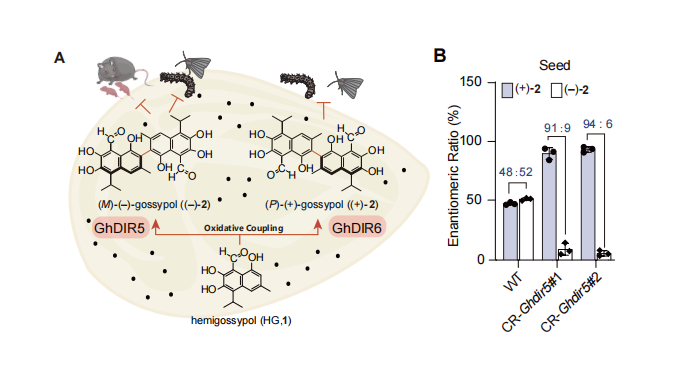On March 17, 2023, a research article entitled “Dirigent gene editing of gossypol enantiomers for toxicity-depleted cotton seeds” was published by the international journal Nature Plants, which was reported by Xiao-Ya Chen’s Group from the CAS Center for Excellence in Molecular Plant Sciences/Institute of Plant Physiology and Ecology/National Key Laboratory of Plant Molecular Genetics. In this study, two novel dirigent proteins from Gossypium hirsutum were shown to be responsible for the oxidative coupling of hemigossypol to (–)- and (+)-gossypol, respectively. The (–)-gossypol-forming protein was removed from cotton seeds through genome editing, significantly reducing their toxicity.
Gossypol, the most significant terpenoid phytoalexin in cotton, is widely distributed in cotton plants of the Malvaceae family. Oxidative free radical dimerization of hemigossypol forms two axially chiral isomers, with (–)-gossypol being biologically active towards mammals, and its accumulation in cottonseeds poses health concerns (FIG. 1A). In contrast, (+)-gossypol does not affect sperm production in mammals, but has similar anti-insect and antimicrobial activity to (–)-gossypol. Although agronomic selection has produced cotton varieties completely free of gossypol, these cultivars are susceptible to insect attack. Cotton seeds that selectively inhibit the (–)-gossypol formation while retaining the (+)-gossypol would reduce the spermicide activity of seed productds while retaining their resistance to pathogenic fungus and insects.
The authors carried out an in-depth gene expression analysis, which identified two dirigent protein (DIR) genes, GhDIR5 and GhDIR6. Enzymatic assays showed that GhDIR5 and GhDIR6 control (+)-gossypol and (–)-gossypol biosynthesis, respectively (FIG. 1A). Disruption of GhDIR5 by CRISPR-Cas9-mediated gene editing resulted in elimination of (–)-gossypol accumulation (FIG. 1B), but no significant changes in the levels of (+)-gossypol and other structurally related phytoalexins, which maintained the plant resistance to insect herbivores. Notably, the (–)-gossypol free or ultra-low cottonseeds exhibited significantly reduced toxicity to mice and several cell lines compared to the wide type seeds. Tracing the evolutionary trajectory revealed that GhDIR5, which resides in a chromosome region comprising tandemly arrayed DIR genes, was functionally innovated following local gene duplication(s). In addition, molecular modeling and mutagenesis analysis disclosed that the interconversion of (+)- and (–)-gossypol forming DIRs involves only a limited number of amino acid residues in the substrate-binding pocket.
This study provides valuable information to understand the mechanism underpinning the enantiomerism determination and to design metabolite chirality through protein engineering. This is also the first report of genetic selection of natural product enantiomers by genome editing, which opens up a new way to facilitate the asymmetric synthesis of complex natural products, with benefits for crop breeding as well. GhDIR5 could be used for the production of (–)-gossypol or its natural analogs to provide the leading compounds for antisperm, antiviral and antineoplastic drugs.
Ph.D candidate Jia-Ling Lin from Xiao-Ya Chen Research Group is the first authors of the paper. Associate professor Jin-Quan Huang and professor Xiao-Ya Chen are the corresponding authors of the paper. Xin Fang, Associate professor of State Key Laboratory of Phytochemistry and Plant Resources in West China, Kunming Institute of Botany, CAS; Jian-Xu Li, Associate professor of CAS Center for Excellence in Molecular Plant Sciences; Zhi-Wen Chen, professor of Hainan Yazhou Bay Seed Laboratory; Baofu Xu, Shandong Laboratory of Yantai Drug Discovery/Bohai Rim Advanced Research Institute for Drug Discovery, State Key Laboratory of Drug Research/Shanghai Institute of Materia Medica/CAS; Associate professor Ling-Jian Wang, Ning-Jing Liu and other members in Xiao-Ya Chen Research Group participated in the study. Professor Cathie Martin from the United Kingdom also contributed to this work. The research work was supported by the National Key R&D Program of China, the Pilot Project of the Chinese Academy of Sciences, and the National Natural Science Foundation of China.
Figure 1. GhDIR5 knock out blocks (–)-gossypol formation in cotton seeds. (A) Laccase-mediated oxidative homocoupling of hemigossypol (1) results in two atropisomers of gossypol (2), GhDIR5 and GhDIR6 control the biosynthesis of (–)- and (+)-gossypol, respectively. (B) CRISPR/Cas9-mediated GhDIR5 editing (CR-Ghdir5) blocked the biosynthesis of (–)-2 in cotton seeds, which significantly changed the enantiomeric ratio of (±)-2 in CR-Ghdir5 cotton seeds.
Dr. Xiao-Ya Chen, Professor; Jin-Quan Huang, Associate professor
CAS Center for Excellence in Molecular Plant Sciences
Email: xychen@cemps.ac.cn and huangjinquan@cemps.ac.cn
